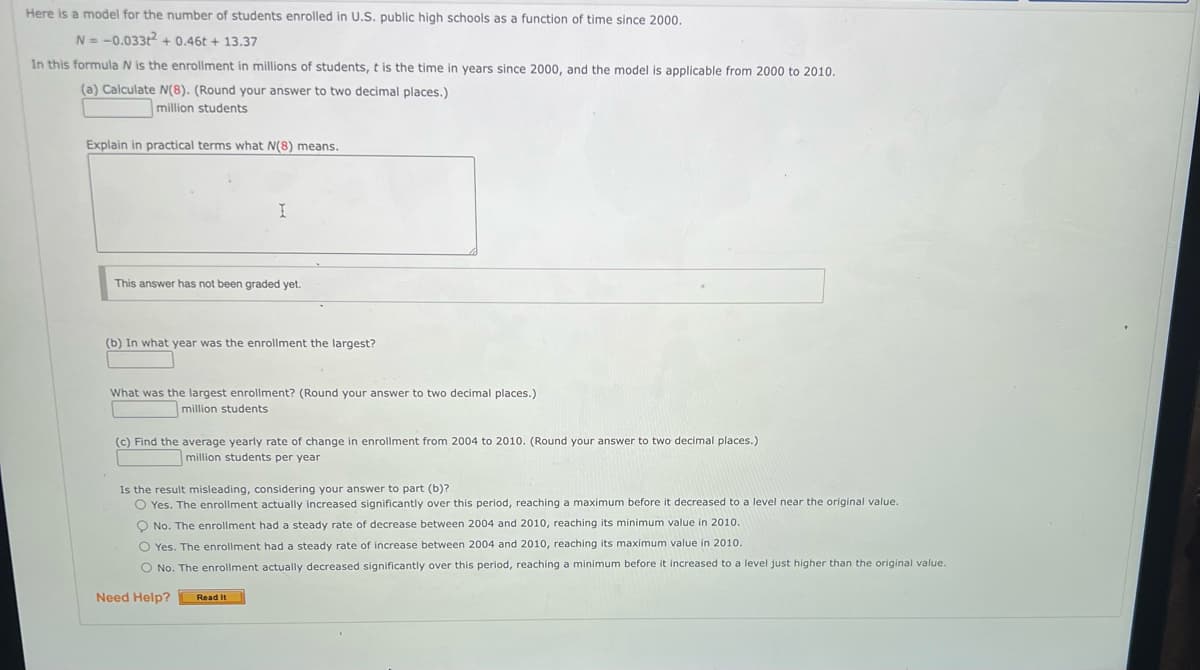students enrolled in U.S. public high schools as a function of time since 2000. N=-0.033² +0.46t + 13.37 In this formula N is the enrollment in millions of students, t is the time in years since 2000, and the model is applicable from 2000 to 2010. (a) Calculate N(8). (Round your answer to two decimal places.) million students Explain in practical terms what N(8) means. I This answer has not been graded yet. (b) In what year was the enrollment the largest? What was the largest enrollment? (Round your answer to two decimal places.) million students (c) Find the average yearly rate of change in enrollment from 2004 to 2010. (Round your answer to two decimal places.) million students per year Is the result misleading, considering your answer to part (b)? O Yes. The enrollment actually increased significantly over this period, reaching a maximum before it decreased to a level near the original value. O No. The enrollment had a steady rate of decrease between 2004 and 2010, reaching its minimum value in 2010. O Yes. The enrollment had a steady rate of increase between 2004 and 2010, reaching its maximum value in 2010. O No. The enrollment actually decreased significantly over this period, reaching a minimum before it increased to a level just higher than the original value. Need Help? Read It
students enrolled in U.S. public high schools as a function of time since 2000. N=-0.033² +0.46t + 13.37 In this formula N is the enrollment in millions of students, t is the time in years since 2000, and the model is applicable from 2000 to 2010. (a) Calculate N(8). (Round your answer to two decimal places.) million students Explain in practical terms what N(8) means. I This answer has not been graded yet. (b) In what year was the enrollment the largest? What was the largest enrollment? (Round your answer to two decimal places.) million students (c) Find the average yearly rate of change in enrollment from 2004 to 2010. (Round your answer to two decimal places.) million students per year Is the result misleading, considering your answer to part (b)? O Yes. The enrollment actually increased significantly over this period, reaching a maximum before it decreased to a level near the original value. O No. The enrollment had a steady rate of decrease between 2004 and 2010, reaching its minimum value in 2010. O Yes. The enrollment had a steady rate of increase between 2004 and 2010, reaching its maximum value in 2010. O No. The enrollment actually decreased significantly over this period, reaching a minimum before it increased to a level just higher than the original value. Need Help? Read It
Glencoe Algebra 1, Student Edition, 9780079039897, 0079039898, 2018
18th Edition
ISBN:9780079039897
Author:Carter
Publisher:Carter
Chapter8: Polynomials
Section8.1: Adding And Subtracting Polynomials
Problem 44PPS
Related questions
Question

Transcribed Image Text:Here is a model for the number of students enrolled in U.S. public high schools as a function of time since 2000.
N=-0.033t² +0.46t + 13.37
In this formula N is the enrollment in millions of students, t is the time in years since 2000, and the model is applicable from 2000 to 2010.
(a) Calculate N(8). (Round your answer to two decimal places.)
million students
Explain in practical terms what N(8) means.
I
This answer has not been graded yet.
(b) In what year was the enrollment the largest?
What was the largest enrollment? (Round your answer to two decimal places.)
million students
(c) Find the average yearly rate of change in enrollment from 2004 to 2010. (Round your answer to two decimal places.)
million students per year
Is the result misleading, considering your answer to part (b)?
O Yes. The enrollment actually increased significantly over this period, reaching a maximum before it decreased to a level near the original value.
O No. The enrollment had a steady rate of decrease between 2004 and 2010, reaching its minimum value in 2010.
O Yes. The enrollment had a steady rate of increase between 2004 and 2010, reaching its maximum value in 2010.
O No. The enrollment actually decreased significantly over this period, reaching a minimum before it increased to a level just higher than the original value.
Need Help?
Expert Solution
This question has been solved!
Explore an expertly crafted, step-by-step solution for a thorough understanding of key concepts.
Step by step
Solved in 2 steps

Recommended textbooks for you

Glencoe Algebra 1, Student Edition, 9780079039897…
Algebra
ISBN:
9780079039897
Author:
Carter
Publisher:
McGraw Hill

Big Ideas Math A Bridge To Success Algebra 1: Stu…
Algebra
ISBN:
9781680331141
Author:
HOUGHTON MIFFLIN HARCOURT
Publisher:
Houghton Mifflin Harcourt


Glencoe Algebra 1, Student Edition, 9780079039897…
Algebra
ISBN:
9780079039897
Author:
Carter
Publisher:
McGraw Hill

Big Ideas Math A Bridge To Success Algebra 1: Stu…
Algebra
ISBN:
9781680331141
Author:
HOUGHTON MIFFLIN HARCOURT
Publisher:
Houghton Mifflin Harcourt


College Algebra
Algebra
ISBN:
9781305115545
Author:
James Stewart, Lothar Redlin, Saleem Watson
Publisher:
Cengage Learning

Linear Algebra: A Modern Introduction
Algebra
ISBN:
9781285463247
Author:
David Poole
Publisher:
Cengage Learning

Algebra & Trigonometry with Analytic Geometry
Algebra
ISBN:
9781133382119
Author:
Swokowski
Publisher:
Cengage